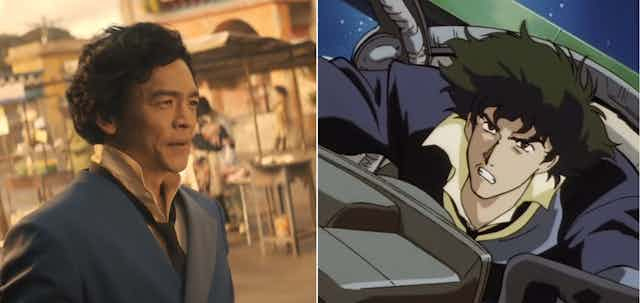The classic 1998 anime series Cowboy Bebop is back in the public eye with a bold and much-anticipated live-action adaptation arriving on Netflix on Nov. 19.
The occasion offers a moment to reflect upon the vast cultural and artistic significance of an anime that crossed literal and figurative borders to help carve out an international audience for the Japanese animation industry.
The original Cowboy Bebop played a monumental role in establishing the transnational potential of anime. Its genre-bending storyline about space-faring bounty hunters offered viewers a pastiche of American mafia movies, Italian westerns, Japanese cyberpunk, Hong-Kong style martial arts movies and many other international influences.
Accompanying the sampling of story genres is an equally diverse sampling of international music, seamlessly integrated. Music is an intrinsic part to both the atmosphere and storytelling of Bebop, which features jazz, funk, hip-hop, blues, rock, metal and beyond.
Anime hits western pop culture
First released on home video in the West in 2000, Cowboy Bebop rode one of anime’s earliest major waves into western popular culture.
Thanks to the groundwork laid by shows like Sailor Moon, Dragon Ball Z and Gundam Wing, Bebop not only found a sizable audience on DVD, but practically became an overnight success when it was selected as the first anime to be broadcast on Cartoon Network’s burgeoning late-night programming block Adult Swim in 2001.
As noted by media scholar Sandra Annett, Cowboy Bebop represented a work of art that existed outside national boundaries — what she calls a “shift towards post-nationalism.” The series, set in the year 2071, and anchored in the civilization hub of the planet Mars, presented a dynamic, compelling and surprisingly cohesive melting pot of disparate cultural influences, all of which combine to articulate a story that is — at its core — globally inclusive.
Its critical acclaim and financial success speaks to a seismic shift in existing media landscapes in the 1980s leading into the 21st century. Communications scholar Fabienne Darling-Wolf explores how media producers in Japan were among others who found international reach, inviting viewers to negotiate their own sense of place with “cultural products, images and information increasingly disconnected from their place of origin.”
Style and substance

Though awash in style and verve, Cowboy Bebop wasn’t lacking in substance. At the core of the bounty hunting adventure serial was a poignant relationship between a pair of now-iconic lead characters, Faye Valentine and Spike Spiegel. The two find themselves emotionally held at a distance from each other in consequence of a Shakespearean divide: a woman who can’t reconnect to her past and a man who can’t envision a future.
The origins of Bebop itself seem almost too impossible to be true. The show was a production by Sunrise, the anime studio best-known for the Gundam franchise. It was originally intended as a vehicle to sell spaceship toys by parent company Bandai before that idea was abandoned.
Many of the creative staff were studio veterans. Director Shinichiro Watanabe, writer Keiko Nobumoto, character designer Toshihiro Kawamoto and composer Yoko Kanno had previously collaborated on beloved series such as Mobile Suit Gundam 0083: Stardust Memory and Macross Plus, the latter of which was a cult hit abroad.
Standout music, dubbing
Bebop‘s soundtrack was as eclectic as its influences, and Kanno’s career skyrocketed because of the series. Its bombastic opening theme “Tank!” and moody closer “The Real Folk Blues” remain beloved to this day. And most of the show’s episode titles are named after famous songs and albums.
Kanno’s name has since become industry royalty, to the point that she was selected to compose the music for the ascension of Japan’s Emperor Naruhito in 2019. Unsurprisingly, Kanno is back for the upcoming Netflix series.
Even the work of translation received accolades, as the English language dub of Cowboy Bebop is considered a benchmark of English-language dubbing for the richness and depth of the English voice acting performances: a work of art in itself.
Continued fandom
There was a continued life in western fandom for the series well after its final entry, the feature film Cowboy Bebop: Knockin’ on Heaven’s Door in 2001.
Even 20 years later, the anime series routinely tops “best anime” lists by fans and critics alike. As film critic Chris Stuckmann writes in Anime Impact: “No anime in history has the effervescent pop-magic of Cowboy Bebop.… All it takes is a few glances and you’re hooked.”
As a new generation receives its own iteration of Cowboy Bebop, the shadow of the original looms deservedly large. As recent successes such as Squid Game and Demon Slayer remind us, the media landscape of 2021 cares little for national boundaries.
This wasn’t always the case back in 1998, when a crew of hard-luck bounty hunters sailed a modified fishing trawler into television history. Set among the stars, as it was, Cowboy Bebop was truly universal.

